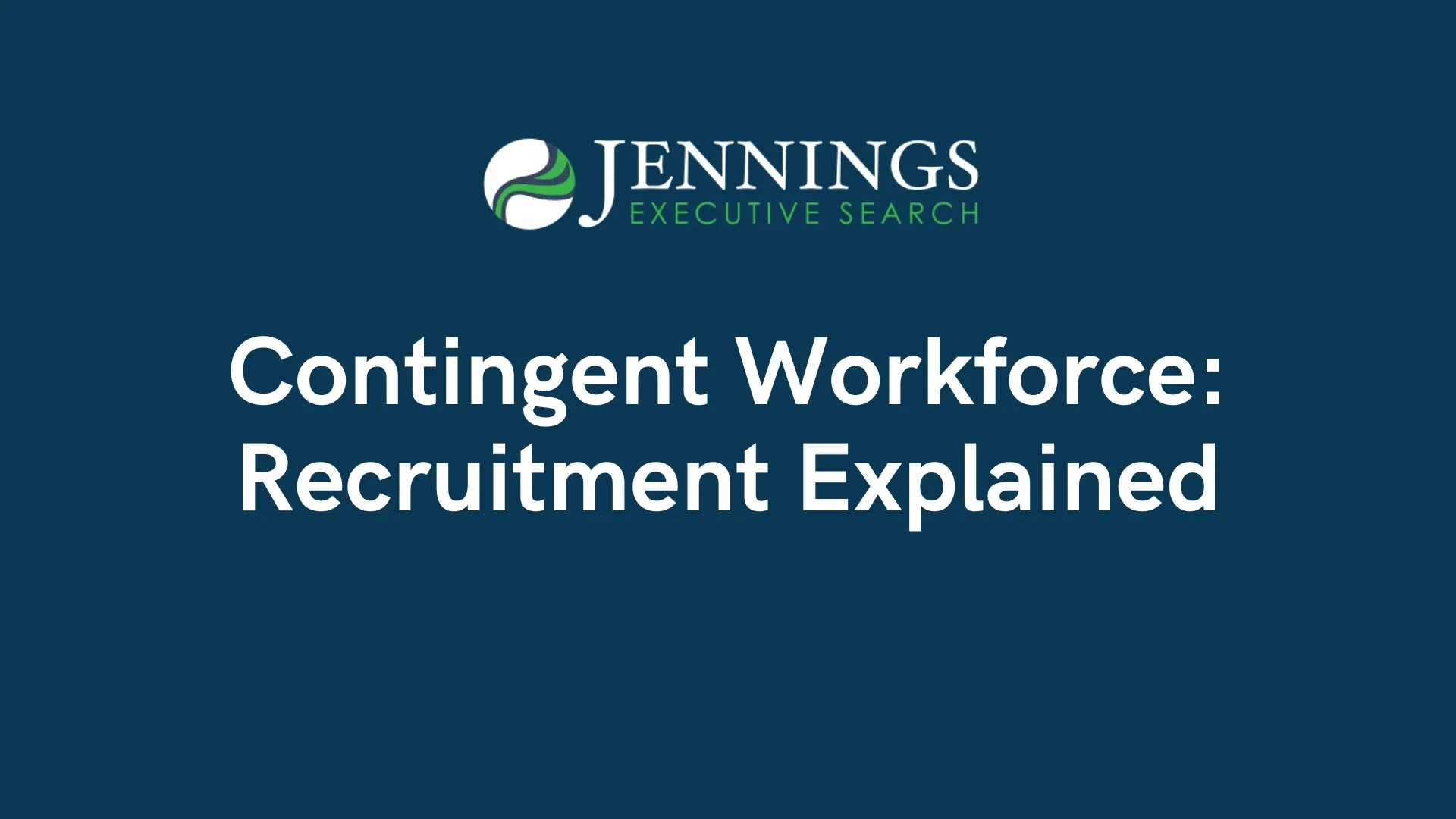Contingent Workforce: Recruitment Explained
Uncover the ins and outs of recruiting contingent workforce with our comprehensive guide.

In the ever-evolving world of business, the concept of a contingent workforce has emerged as a significant trend. This shift towards a more flexible employment model is reshaping the way companies recruit and manage their human resources. But what exactly is a contingent workforce? And how does it impact the recruitment process? This glossary entry aims to answer these questions and more, providing an in-depth exploration of the contingent workforce and its implications for recruitment.
Before we dive into the intricacies of recruiting a contingent workforce, let's first establish a clear understanding of what this term means. A contingent workforce is a labor pool whose members are hired by an organization on an on-demand basis. It can include freelancers, independent professionals, temporary contract workers, and consultants. These individuals are not employed by the company in the traditional sense, but they provide their services to the company as needed.
Understanding the Contingent Workforce
The contingent workforce is characterized by its flexibility. Unlike traditional employees who are hired for an indefinite period, contingent workers are engaged for specific projects or for a defined period. This flexibility can provide companies with a number of benefits, including cost savings, access to specialized skills, and the ability to quickly scale up or down in response to business needs.
However, managing a contingent workforce can also present unique challenges. These can include issues related to worker classification, compliance with labor laws, and the management of a dispersed and diverse workforce. Understanding these challenges is key to effectively leveraging the benefits of a contingent workforce.
The Rise of the Contingent Workforce
The rise of the contingent workforce is largely driven by changes in the business environment and labor market. Technological advancements have made it easier for companies to connect with and manage remote workers. At the same time, many professionals are seeking greater flexibility and autonomy in their work, leading them to pursue freelance or contract work.
Moreover, the economic uncertainty caused by events such as the global financial crisis and the COVID-19 pandemic has led many companies to seek more flexible staffing solutions. By engaging contingent workers, companies can more easily adjust their workforce in response to changing market conditions.
Types of Contingent Workers
Contingent workers can come in many forms. Some are freelancers who offer their services on a project-by-project basis. Others are temporary workers who are hired for a specific period. Consultants, on the other hand, are typically experts in a specific field who are engaged to provide advice or solutions to specific business problems.
Another type of contingent worker is the independent contractor. These are self-employed individuals who provide services to a company under a contract for services. Unlike employees, independent contractors are not subject to the same legal and tax obligations as employees, which can make them an attractive option for companies seeking flexibility.
Recruiting a Contingent Workforce
Recruiting a contingent workforce involves a different approach compared to hiring traditional employees. This is due to the unique characteristics and needs of contingent workers, as well as the legal and regulatory considerations associated with contingent work.
One of the key aspects of recruiting a contingent workforce is sourcing candidates. This can involve a variety of methods, including online job platforms, professional networks, and recruitment agencies. Companies may also use a Vendor Management System (VMS) to manage their contingent workforce recruitment process.
Attracting Contingent Workers
Attracting contingent workers requires a different strategy compared to attracting traditional employees. Contingent workers are typically looking for flexibility, interesting projects, and competitive pay. Therefore, companies need to highlight these aspects in their job postings and communications with potential candidates.
Additionally, companies need to build a strong employer brand that appeals to contingent workers. This can involve showcasing the company's culture, values, and projects, as well as providing testimonials from other contingent workers.
Screening and Selecting Contingent Workers
Screening and selecting contingent workers is another critical aspect of the recruitment process. This involves assessing candidates' skills, experience, and fit with the company's needs. It's also important to verify the candidate's employment status to ensure compliance with labor laws.
Interviewing contingent workers can also be different from interviewing traditional employees. The focus should be on the specific project or role the worker will be engaged for, rather than on long-term career prospects. It's also important to discuss the terms of the engagement, including payment, duration, and expectations.
Managing a Contingent Workforce
Once a contingent worker is engaged, the next challenge is managing them effectively. This involves ensuring they have the resources and support they need to perform their role, as well as managing their performance and engagement.
One of the key challenges in managing a contingent workforce is maintaining a sense of connection and engagement. Since contingent workers are not traditional employees, they may not feel a strong sense of loyalty or commitment to the company. Therefore, companies need to make an extra effort to engage and motivate these workers.
Onboarding Contingent Workers
Onboarding is a critical step in managing a contingent workforce. This process helps to ensure that the worker understands their role and responsibilities, and has the tools and information they need to perform their job. It's also an opportunity to establish a positive working relationship and set the tone for the engagement.
However, onboarding a contingent worker can be different from onboarding a traditional employee. The process should be tailored to the specific needs and circumstances of the contingent worker, and should focus on the specific project or role they will be engaged for.
Performance Management
Performance management is another important aspect of managing a contingent workforce. This involves setting clear expectations, providing regular feedback, and addressing any performance issues promptly and effectively.
However, managing the performance of a contingent worker can be more challenging than managing the performance of a traditional employee. This is due to the temporary nature of the engagement, as well as the potential lack of direct supervision. Therefore, companies need to establish clear performance metrics and communication channels to effectively manage the performance of their contingent workforce.
Legal and Regulatory Considerations
Engaging a contingent workforce also involves a number of legal and regulatory considerations. These can include issues related to worker classification, employment rights, and tax obligations. Companies need to be aware of these issues and ensure they are in compliance with all relevant laws and regulations.
One of the key legal considerations is the classification of workers. Misclassifying a worker as a contractor when they should be classified as an employee can result in significant legal and financial penalties. Therefore, companies need to carefully assess the nature of their relationship with each worker to ensure they are correctly classified.
Employment Rights
Another important legal consideration is employment rights. Contingent workers typically do not have the same employment rights as traditional employees. However, they are still entitled to certain rights, such as the right to a safe and healthy work environment, and the right to be free from discrimination and harassment.
Companies need to ensure they are respecting these rights and treating their contingent workers fairly. This can involve providing appropriate training and support, and implementing policies and procedures to address any issues that arise.
Tax Obligations
Finally, engaging a contingent workforce can have tax implications. Depending on the nature of the relationship, the company may be responsible for withholding and remitting taxes on behalf of the worker. Alternatively, the worker may be responsible for managing their own tax obligations.
Companies need to understand these obligations and ensure they are in compliance. This can involve consulting with a tax professional or seeking advice from a government agency.
Conclusion
In conclusion, the contingent workforce represents a significant shift in the way companies recruit and manage their human resources. By understanding the unique characteristics and needs of this workforce, companies can leverage its benefits while managing its challenges effectively.
Whether you're a business looking to engage a contingent workforce, or a professional considering contingent work, understanding the dynamics of this employment model is key to navigating the modern world of work.
If you're a company poised to embrace the flexibility of a contingent workforce, or a professional with the expertise to fill high-level, strategic roles, Jennings Executive Search is your partner in navigating this dynamic employment landscape. With a wealth of experience in placing top-tier candidates in roles such as Director of Pricing Strategy and Global Pricing Lead, we understand the intricacies of executive recruitment. Learn More about how Jennings Executive can help you harness the potential of a contingent workforce to drive your business forward.
Recommended For You

How to Spot Pricing Talent When You’re Not a Pricing Expert
Hiring pricing talent without pricing expertise is possible—focus on role-specific skills, real business impact, and situational thinking to assess how candidates drive margins and decisions.

The Hidden Burnout Risk In Pricing Roles
Pricing burnout is real: high conflict, low control—fix it with authority and systems.

Talent Benchmarking for Pricing Roles
Align pricing role scope, title & comp with real market benchmarks before hiring.

The Pricing Analyst's Toolkit
The essential pricing analyst toolkit—and what truly drives impact in the role.

Why Your Pricing Team Can't Be All Strategy Or All Execution
Pricing teams break when strategy and execution are out of balance—here’s how to fix it.

The Pricing Career Ladder - From Analyst To VP and Beyond
Inside the pricing career ladder: what drives growth from analyst to VP


